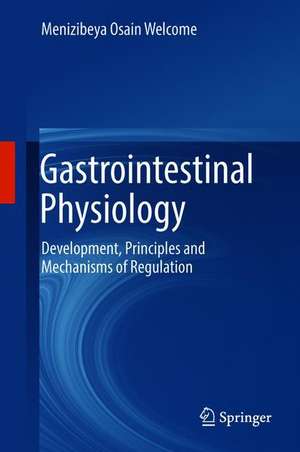Gastrointestinal Physiology: Development, Principles and Mechanisms of Regulation
Autor Menizibeya Osain Welcomeen Limba Engleză Hardback – 9 iul 2018
Chapters on the roles of the gut as an endocrine, exocrine and neural organ, as well as its microbiome functions, broaden readers’ understanding of the multi-organ networks in the human body. To help illustrate the interconnections between the physiological concepts, principles and clinical presentations, it outlines clinical examples such as pathologies that link basic science with clinical practice in special “clinical correlates” sections. Covering both traditional and contemporary topics, it is a valuable resource for biomedical students, as well as healthcare and scientific professionals.
| Toate formatele și edițiile | Preț | Express |
|---|---|---|
| Paperback (1) | 1645.78 lei 6-8 săpt. | |
| Springer International Publishing – 5 ian 2019 | 1645.78 lei 6-8 săpt. | |
| Hardback (1) | 2156.84 lei 6-8 săpt. | |
| Springer International Publishing – 9 iul 2018 | 2156.84 lei 6-8 săpt. |
Preț: 2156.84 lei
Preț vechi: 2270.35 lei
-5% Nou
Puncte Express: 3235
Preț estimativ în valută:
412.69€ • 430.93$ • 340.80£
412.69€ • 430.93$ • 340.80£
Carte tipărită la comandă
Livrare economică 15-29 aprilie
Preluare comenzi: 021 569.72.76
Specificații
ISBN-13: 9783319910550
ISBN-10: 3319910558
Pagini: 872
Ilustrații: XXI, 1028 p. 210 illus., 208 illus. in color.
Dimensiuni: 155 x 235 x 63 mm
Greutate: 1.74 kg
Ediția:1st ed. 2018
Editura: Springer International Publishing
Colecția Springer
Locul publicării:Cham, Switzerland
ISBN-10: 3319910558
Pagini: 872
Ilustrații: XXI, 1028 p. 210 illus., 208 illus. in color.
Dimensiuni: 155 x 235 x 63 mm
Greutate: 1.74 kg
Ediția:1st ed. 2018
Editura: Springer International Publishing
Colecția Springer
Locul publicării:Cham, Switzerland
Cuprins
History of Development of Gastrointestinal Physiology: From Antiquity to Modern Period and the Birth of Modern Digestive Physiology.- Structural and Functional Organization of Gastrointestinal Tract.- Cellular Organization of the GI Tract.- Intercellular Network of the GI Tract.- Molecular Basis of Regulation of GI Functioning.- Gastrointestinal Growth and Development: From Zygote to Adulthood.- Gastrointestinal Motor Function.- Gastrointestinal Hormones.- Neural Secretions and Regulation of Gut Functions.- Gut Immunomodulatory Functions.- Gastrointestinal Exocrine (Lumencrine) Secretions. The Reception Theory as the Basis for Developing the First Antisecretory Pharmacotherapy Drugs.- Chemical Digestion, Absorption and Transport.- Metabolic Functions of the Gut.- Excretory Functions of the GI Tract. Defecation.- Physiology of Helicobacter pylori.- Functional Relationship between the Gut and Other Organs of the Body.- Gastrointestinal Functioning in Extreme Conditions of Temperature, Pressure and Gravity.- Appendix.
Textul de pe ultima copertă
This book offers one of the most comprehensive reviews in the field of gastrointestinal (GI) physiology, guiding readers on a journey through the complete digestive tract, while also highlighting related organs and glandular systems. It is not solely limited to organ system physiology, and related disciplines like anatomy and histology, but also examines the molecular and cellular processes that keep the digestive system running. As such, the book provides extensive information on the molecular, cellular, tissue, organ, and system levels of functions in the GI system.
Chapters on the roles of the gut as an endocrine, exocrine and neural organ, as well as its microbiome functions, broaden readers’ understanding of the multi-organ networks in the human body. To help illustrate the interconnections between the physiological concepts, principles and clinical presentations, it outlines clinical examples such as pathologies that link basic science with clinical practice in special “clinical correlates” sections. Covering both traditional and contemporary topics, it is a valuable resource for biomedical students, as well as healthcare and scientific professionals.
Chapters on the roles of the gut as an endocrine, exocrine and neural organ, as well as its microbiome functions, broaden readers’ understanding of the multi-organ networks in the human body. To help illustrate the interconnections between the physiological concepts, principles and clinical presentations, it outlines clinical examples such as pathologies that link basic science with clinical practice in special “clinical correlates” sections. Covering both traditional and contemporary topics, it is a valuable resource for biomedical students, as well as healthcare and scientific professionals.
Caracteristici
Presents detailed mechanisms of the regulation of gastrointestinal (GI) functioning in health and disease
Equips readers with comprehensive knowledge of all organs related to the GI system
Treats both theoretical and practical aspects of gastroenterology
Equips readers with comprehensive knowledge of all organs related to the GI system
Treats both theoretical and practical aspects of gastroenterology






















